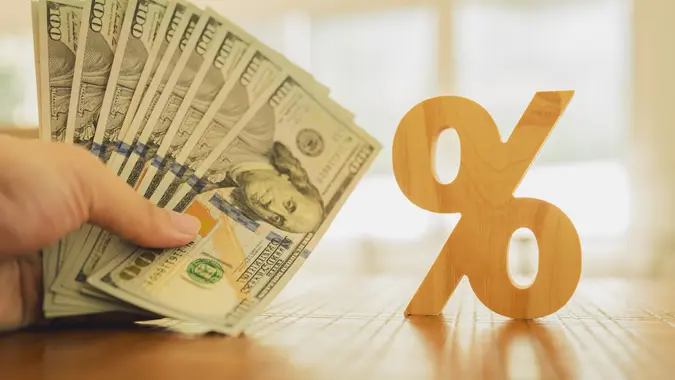Average American Spends This Much on Utility Bills — See How You Stack Up

Commitment to Our Readers
GOBankingRates' editorial team is committed to bringing you unbiased reviews and information. We use data-driven methodologies to evaluate financial products and services - our reviews and ratings are not influenced by advertisers. You can read more about our editorial guidelines and our products and services review methodology.

20 Years
Helping You Live Richer

Reviewed
by Experts

Trusted by
Millions of Readers
Utility bills are often overlooked when computing the cost to own a home or rent an apartment. However, depending on where you live, this cost can actually be quite substantial — even a bit unpredictable.
Between not really knowing what your consumption rate will be on a month-to-month basis and having no control over the rate that your utility company charges you, bills can vary dramatically over time. This can make it hard to budget for this expense.
One way to budget for your utility expense is to calculate what your total cost was for the prior year and average it out on a per-month basis, perhaps factoring in a small increase to account for rising inflation. If you have no track record of paying utility bills, it can help to check out how much the average American spends on utilities, particularly in your area.
To help with this comparison, GOBankingRates surveyed 1,021 Americans in Oct. 2023 regarding how much they spend on a variety of expenses, including utilities. The survey also asked questions regarding more general financial topics and how Americans’ spending habits have changed over time. Here are some of the utility-focused results from the survey, along with a look at how you can help contain your own utility expenses.
How Much Are Average Americans Spending on Utilities?
For purposes of the GOBankingRates survey, electricity, gas/heat and water were considered “utility expenses.” Of the 1,021 survey respondents, 11.85% said they spent $500 or more per month on utilities. However, the top two answers were “under $200” and “$200-$300,” garnering 29.87% and 30.17% of responses, respectively. Just over 10% of survey participants said they spent $401 to $500 per month, while 17.83% indicated their average monthly cost was $301-400.
These figures match up fairly well with data from the U.S. Bureau of Labor Statistics. For 2021-22, the most recent year for which data is available, the BLS said that the average American spent $4,387 per year on “utilities, fuels, and public services.” That amounts to $365.58 per month on average.
Has Inflation Played a Role?
One of the key questions in the survey was, “What spending/saving habits have you had to change in the last year due to inflation/rising prices?” While not the top response, 17.63% of respondents indicated that they have had to change their utility spending/saving habits in response to rising inflation over the past year.
The most popular responses to this question were entertainment, food, and vacation expenses, with 57.20%, 54.26% and 45.85% of respondents choosing these categories. This makes sense since those are discretionary expense categories that can be more readily cut back than utility expenses. The fact that nearly 20% of respondents indicated they had to somehow adjust their utility costs is actually quite high in that context, as it is not an expense that most Americans focus on first.
Are Utility Prices Rising Unexpectedly?
Considering that most Americans know the approximate cost of their utilities on a month-to-month and annual basis, it’s generally a surprise when utility prices are much higher than expected. Yet, 11.17% of survey respondents indicated that rising utility costs were their biggest unexpected expense this year, choosing that option over more traditionally “surprising” categories like food, gas, transportation or housing prices.
This is a particularly surprising choice in light of the spike in gas, food and housing prices in 2023 and may indicate that in some areas, utility prices may be rising dramatically.
How You Can Help Contain Your Utility Expenses
You can’t control the rates that your utility company charges you, so the best way to cut down on your utility costs is to reduce your consumption. Here are some suggestions.
Conduct an Energy Audit
You can hire a professional to see where you may have energy leaks in your home, or you can conduct an assessment yourself. According to the U.S. Department of Energy, you should locate and seal air leaks, check insulation levels, inspect heating and cooling equipment, examine your light bulbs and monitor the usage of your electronics and appliances.
Update Your Appliances
If anything that draws energy in your home is more than 15 years old, you might consider upgrading to a more energy-efficient model, although that will obviously involve an upfront cost in exchange for saving more money down the road.
Change Your Thermostat Settings
The U.S. Department of Energy recommends that you set your winter thermostat at 68 to 70 degrees during the day, and lower at night. In the summer, a setting of 78 is the recommendation.
According to the DOE, if you lower your thermostat by 7 to 10 degrees for 8 hours per day, you can save 10% off your utility bill. The agency also suggests using a programmable thermostat so you can better manage your settings, even when you’re away from your home.
Apply for Low-Income Assistance
The federal government offers a Low Income Home Energy Assistance Program that helps low-income households pay for their cooling and heating bills. Eligibility for LIHEAP services depends on factors including your household size, income, and where you live.
In California, for example, you can qualify for assistance if you’re a two-person household with a monthly income of $3,531 or less. Check with your individual state to determine qualification requirements.
More From GOBankingRates
 Written by
Written by  Edited by
Edited by 

























